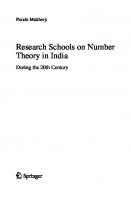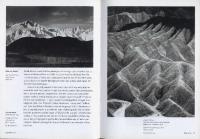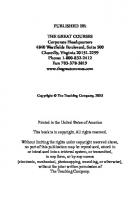Mathematical analysis during the 20th century 0198503946, 9780198503941
Published under the Clarendon Press imprint, this book covers the 20th Century evolution of essential ideas in mathemati
318 77 3MB
English Pages 430 Year 2001
Table of contents :
Cover......Page 1
1 Introduction......Page 3
1.1.1 The great classics on analysis......Page 4
1.1.2 The changing object of analysis......Page 6
1.2.1 The question of subdividing matliematical analysis......Page 14
1.2.2 How to organize the subject......Page 18
2.1.1 Topological axiomatizations......Page 29
2.1.2 Topological algebra......Page 39
2.1.3 Filtrations......Page 42
2.1.5 Complementary inputs......Page 44
2.2.1 An accomplislied subject......Page 46
2.2.2 Generalized topological concepts......Page 47
3.1.1 Lebesgue integration......Page 49
3.1.2 The general concept of measure......Page 57
3.1.4 Period of consolidation......Page 63
3.2.1 Standing problems......Page 65
3.2.2 Abstract formulations......Page 66
3.2.3 Generalized Riemann integrals......Page 70
3.2.4 Outlook......Page 71
4.1.1 New objectives......Page 75
4.1.2 Theory of integral equations......Page 81
4.1.3 Banach spaces......Page 88
4.1.4 Hilbert spaces......Page 94
4.1.5 Von Neumann algebras......Page 97
4.1.6 Banach algebras......Page 100
4.1.7 Distributions......Page 103
4.2.1 Topological vector spaces......Page 108
4.2.3 Frechet spaces, Schwartz spaces, Sobolev spaces......Page 110
4.2.4 Banach space properties......Page 112
4.2.5 Hilbert space properties......Page 115
4.2.6 Banach algebra and $C^\\ast$-algebra properties......Page 116
4.2.8 Nuclearity......Page 119
4.2.9 Von Neumann algebra properties......Page 125
4.2.10 Specific topics......Page 128
5.1.1 Fourier series......Page 131
5.1.2 Invariant measures......Page 139
5.1.3 Almost periodic functions......Page 142
5.1.4 Uniqueness of invariant measures......Page 143
5.1.5 Convolutions......Page 144
5.1.6 An evolution linked to the history of physics......Page 147
5.1.7 Representation theory......Page 152
5.1.8 Structural properties of topological groups......Page 156
5.1.9 Positive-definite functions......Page 157
5.1.10 Harmonic synthesis......Page 159
5.1.11 Metric locally compact Abelian groups......Page 162
5.2.1 Fourier transforms......Page 165
5.2.3 Group representations......Page 168
5.2.4 Remarkable Banach algebras of functions on a locally compact group......Page 171
5.2.5 Specific sets......Page 172
5.2.6 Specific groups......Page 173
5.2.7 Harmonic analysis on semigroups......Page 175
5.2.8 Wavelets......Page 176
5.2.9 Generalized actions......Page 178
6.1.1 Lie groups and Lie algebras......Page 181
6.1.2 Symmetric Riemannian spaces......Page 187
6.1.3 Hubert's problem for Lie groups......Page 189
6.1.4 Representations of Lie groups......Page 190
6.2.1 The wide range of Lie group theory......Page 191
6.2.3 Ergodicity problems......Page 193
6.2.4 Specific classes of Lie groups......Page 194
6.2.5 Extensions of Lie group theory......Page 198
7 Theory of functions and analytic geometry......Page 201
7.1.1 The nineteenth century continued......Page 202
7.1.2 Potential theory......Page 211
7.1.3 Conformal mappings......Page 213
7.1.4 Towards a theory of several complex variables......Page 214
7.2.1 Accomplishments on previous topics......Page 217
7.2.2 Hardy spaces......Page 221
7.2.3 The dominance of the theory of several complex variables......Page 225
7.2.4 Iteration problems......Page 229
8.1.1 New trends for classical problems......Page 231
8.1.2 Fixed point properties......Page 233
8.1.3 From the ordinary differential case to the partial differential case......Page 234
8.2.1 Differential equations......Page 238
8.2.2 Partial differential equations......Page 240
8.2.3 Tentacular subjects......Page 249
9.1.1 The origins of algebraic topology......Page 257
9.1.2 Simplkial theories......Page 263
9.1.3 Homotopy theory......Page 269
9.1.4 Fibres and fibrations......Page 272
9.1.5 The breakthroughs due to Eilenberg, MacLane, and Leray......Page 273
9.2.1 The power of the machinery......Page 277
9.2.2 Generalizations......Page 280
10.1.1 The beginning of the century......Page 282
10.1.2 E.Cartan's work......Page 285
10.1.3 Tensor products and exterior differentials......Page 286
10.1.4 Morse theory......Page 289
10.1.5 Whitney's work......Page 290
10.1.6 DeRham'swork......Page 293
10.1.7 Hodge theory......Page 295
10.1.8 The framing of the subject......Page 299
10.2.1 The status of differentiable manifolds......Page 301
10.2.2 Foliations......Page 304
10.2.3 New objectives......Page 305
10.2.4 From Poincare's heritage......Page 309
10.2.5 Global analysis......Page 312
11.1.1 First results......Page 316
11.1.2 Brownian motion......Page 320
11.1.3 Ergodicity......Page 322
11.1.4 Probabilities as measures......Page 323
11.1.5 Stochastic integrals......Page 326
11.2.1 Probability theory, a part of analysis......Page 327
11.2.2 Dynamical systems and ergodicity......Page 328
11.2.4 Stochastic processes......Page 330
12.1.1 Algebraic geometry and number theory......Page 333
12.1.2 TlieMordell conjecture......Page 336
12.1.3 Transcendence and prime numbers......Page 338
12.1.4 The Riemann conjecture......Page 340
12.2.1 Arithmetical properties......Page 341
12.2.2 Investigations on transcendental numbers......Page 342
12.2.3 A central object of study......Page 343
12.2.5 The general Riemann-Roch theorems......Page 347
12.2.6 $K$-theory......Page 348
12.2.7 Further studies......Page 351
References......Page 352
Index of Names......Page 412
Index of Terms......Page 420
Appendix: List of Symbols......Page 429
Cover......Page 1
1 Introduction......Page 3
1.1.1 The great classics on analysis......Page 4
1.1.2 The changing object of analysis......Page 6
1.2.1 The question of subdividing matliematical analysis......Page 14
1.2.2 How to organize the subject......Page 18
2.1.1 Topological axiomatizations......Page 29
2.1.2 Topological algebra......Page 39
2.1.3 Filtrations......Page 42
2.1.5 Complementary inputs......Page 44
2.2.1 An accomplislied subject......Page 46
2.2.2 Generalized topological concepts......Page 47
3.1.1 Lebesgue integration......Page 49
3.1.2 The general concept of measure......Page 57
3.1.4 Period of consolidation......Page 63
3.2.1 Standing problems......Page 65
3.2.2 Abstract formulations......Page 66
3.2.3 Generalized Riemann integrals......Page 70
3.2.4 Outlook......Page 71
4.1.1 New objectives......Page 75
4.1.2 Theory of integral equations......Page 81
4.1.3 Banach spaces......Page 88
4.1.4 Hilbert spaces......Page 94
4.1.5 Von Neumann algebras......Page 97
4.1.6 Banach algebras......Page 100
4.1.7 Distributions......Page 103
4.2.1 Topological vector spaces......Page 108
4.2.3 Frechet spaces, Schwartz spaces, Sobolev spaces......Page 110
4.2.4 Banach space properties......Page 112
4.2.5 Hilbert space properties......Page 115
4.2.6 Banach algebra and $C^\\ast$-algebra properties......Page 116
4.2.8 Nuclearity......Page 119
4.2.9 Von Neumann algebra properties......Page 125
4.2.10 Specific topics......Page 128
5.1.1 Fourier series......Page 131
5.1.2 Invariant measures......Page 139
5.1.3 Almost periodic functions......Page 142
5.1.4 Uniqueness of invariant measures......Page 143
5.1.5 Convolutions......Page 144
5.1.6 An evolution linked to the history of physics......Page 147
5.1.7 Representation theory......Page 152
5.1.8 Structural properties of topological groups......Page 156
5.1.9 Positive-definite functions......Page 157
5.1.10 Harmonic synthesis......Page 159
5.1.11 Metric locally compact Abelian groups......Page 162
5.2.1 Fourier transforms......Page 165
5.2.3 Group representations......Page 168
5.2.4 Remarkable Banach algebras of functions on a locally compact group......Page 171
5.2.5 Specific sets......Page 172
5.2.6 Specific groups......Page 173
5.2.7 Harmonic analysis on semigroups......Page 175
5.2.8 Wavelets......Page 176
5.2.9 Generalized actions......Page 178
6.1.1 Lie groups and Lie algebras......Page 181
6.1.2 Symmetric Riemannian spaces......Page 187
6.1.3 Hubert's problem for Lie groups......Page 189
6.1.4 Representations of Lie groups......Page 190
6.2.1 The wide range of Lie group theory......Page 191
6.2.3 Ergodicity problems......Page 193
6.2.4 Specific classes of Lie groups......Page 194
6.2.5 Extensions of Lie group theory......Page 198
7 Theory of functions and analytic geometry......Page 201
7.1.1 The nineteenth century continued......Page 202
7.1.2 Potential theory......Page 211
7.1.3 Conformal mappings......Page 213
7.1.4 Towards a theory of several complex variables......Page 214
7.2.1 Accomplishments on previous topics......Page 217
7.2.2 Hardy spaces......Page 221
7.2.3 The dominance of the theory of several complex variables......Page 225
7.2.4 Iteration problems......Page 229
8.1.1 New trends for classical problems......Page 231
8.1.2 Fixed point properties......Page 233
8.1.3 From the ordinary differential case to the partial differential case......Page 234
8.2.1 Differential equations......Page 238
8.2.2 Partial differential equations......Page 240
8.2.3 Tentacular subjects......Page 249
9.1.1 The origins of algebraic topology......Page 257
9.1.2 Simplkial theories......Page 263
9.1.3 Homotopy theory......Page 269
9.1.4 Fibres and fibrations......Page 272
9.1.5 The breakthroughs due to Eilenberg, MacLane, and Leray......Page 273
9.2.1 The power of the machinery......Page 277
9.2.2 Generalizations......Page 280
10.1.1 The beginning of the century......Page 282
10.1.2 E.Cartan's work......Page 285
10.1.3 Tensor products and exterior differentials......Page 286
10.1.4 Morse theory......Page 289
10.1.5 Whitney's work......Page 290
10.1.6 DeRham'swork......Page 293
10.1.7 Hodge theory......Page 295
10.1.8 The framing of the subject......Page 299
10.2.1 The status of differentiable manifolds......Page 301
10.2.2 Foliations......Page 304
10.2.3 New objectives......Page 305
10.2.4 From Poincare's heritage......Page 309
10.2.5 Global analysis......Page 312
11.1.1 First results......Page 316
11.1.2 Brownian motion......Page 320
11.1.3 Ergodicity......Page 322
11.1.4 Probabilities as measures......Page 323
11.1.5 Stochastic integrals......Page 326
11.2.1 Probability theory, a part of analysis......Page 327
11.2.2 Dynamical systems and ergodicity......Page 328
11.2.4 Stochastic processes......Page 330
12.1.1 Algebraic geometry and number theory......Page 333
12.1.2 TlieMordell conjecture......Page 336
12.1.3 Transcendence and prime numbers......Page 338
12.1.4 The Riemann conjecture......Page 340
12.2.1 Arithmetical properties......Page 341
12.2.2 Investigations on transcendental numbers......Page 342
12.2.3 A central object of study......Page 343
12.2.5 The general Riemann-Roch theorems......Page 347
12.2.6 $K$-theory......Page 348
12.2.7 Further studies......Page 351
References......Page 352
Index of Names......Page 412
Index of Terms......Page 420
Appendix: List of Symbols......Page 429










